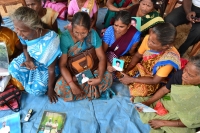

Gross human rights infringements are shockingly regular in armed – conflicts and under harsh systems, both coming from and strengthening an atmosphere of exemption. In the fallout of the unrest, tending to those abominations is a fundamental piece of reconstructing society.
Transitional equity alludes to the variety of existing instruments, legal or not, to play out this undertaking. While reflecting on the past, transitional equity additionally fills a forward-looking need as it soothes wounds, cultivates social exchange, and strengthens the standard of law. In a perfect world, it likewise addresses the basic foundations of the contention, for example, imbalances and segregation, to avert the resurgence of savagery and to fabricate enduring harmony.
There are four pillars of Transitional Justice : Truth which is fact-finding process into human rights violations by non- judicial bodies; Justice which includes criminal prosecutions for at least the most responsible for the most serious crimes; Reparations for human rights violations taking a variety of forms: individual, collective, material, and symbolic; Promise of non – recurrence which reformation of laws and institutions, including the police, judiciary, military, and military intelligence.1 Reforms is the methodology used to ensure non – recurrence.
Reparations fundamentally serve to recognize the legitimate commitment of a state to fix the results of humanitarian infringements — either in light of the fact that it directly committed the acts them or it failed to avoid them. Additionally, it is a type of indication to those exploited that the state is focused on tending to the main drivers of past infringements and guaranteeing they won’t occur once more.
With their material and symbolic advantages, reparations are critical to those exploited since they believed to be the most immediate and significant method for delivering justice. However, they are most often than not given the least priority and at the bottom of the ladder when it comes to state financing in most post – conflict developing nations.
However, it must be noted that while financial reparation is important, it is not the only avenue of reparations. Restoration of rights; civil and political, eradicating unjust criminal persecutions, focus on reparative measures are extended towards the families of the victims as a symbolic gesture, recognizing what they had to overcome.
When looking at it from another angle, it can also be seen that Reparations take the form of reveling the truth behind the human rights infringements themselves while symbolic forms of reparations inclusive of apologies, memorials, and commemorations is also imperative for the success of the nation’s healing process.
There is never a blanket solution when it comes to reparations. Victims will have different needs that need to be addressed depending on what they had to endure during the period of conflict. These needs and the type of reparation required may vary according to demographic factors such as social and economic class, gender, race and identity of the victims.
In September 2015, the Sri Lankan government made a remarkable pledge to commit to taking responsibility and accountability and responsibility by endorsing the Human Rights Council’s Resolution 30/1, embracing roads to seeking truth, justice, reparations and institutional change.4
The objective of this article is to examine the progress of the State’s undertakings in the arena of transitional justice.
Following an unprecedented international investigation, the United Nations, in September 2015 released a comprehensive report on the serious human rights violations seen in Sri Lanka during the years 2002 – 2011.
The Sri Lankan government made an array of pledges with regards to their undertakings towards sustainable peace. Human Rights Council (HRC) Resolution 30/1, co-sponsored by the government included such undertakings. The 34th session of the HRC, the High Commissioner highlighted the limited progress in this regard following which the HRC adopted Resolution 34/1 which thus extended the comprehensive report at the Council’s 40th Session in March earlier this year, following which adopted Resolution 40/1 requested “the Government of Sri Lanka to implement fully the measures identified by the Council in its resolution 30/1 that are outstanding.”
The Center for Policy Alternatives summarized the government’s pledges made in 2015 with regards to Reparations: Establishing an Office for Reparations, returning land to civilian owners, demilitarization and the issuance of certificates of absence to families of missing persons.
The Office on Missing Persons Act No. 4 of 2016 led to the establishment of the Office of Missing Persons as an independent commission, commenced operationalization in February 2018. The OMP’s objectives are “to trace and search for the missing, make recommendations towards non – recurrence, ensure the protection of the rights of the missing, the disappeared and their relatives, and to identify proper avenues of redress.”
Regarding to addressing the issue of missing persons, many countries have adopted the issuance of certificates of missing persons. It is considered as an operative interim mechanism to balance the practical and psychological aspirations of family members and loved ones of the missing.
Talk of implementing this measure in Sri Lanka has been in the mill since the time of the Presidential Commission to Investigate into Complaints Regarding Missing Persons. The said certificate entitling the holder to the rights enjoyed by the holder of a certificate of death was proposed under the guidance of the head of the commission, former High Court Judge, Maxwell Paranagama.10 This suggestion is however yet to see the light of day.
Following the passing of the Office for Reparations Act in October 2019, the Office for Reparations was said to commence functions following the appointment of Commissioners in April 2019. The OR is responsible for identifying victims that qualify for reparations and deliver to them the respective compensation individually and collectively. It is the responsibility of the Office for Reparation to identify the aggrieved victims qualified for reparation and provide appropriate compensation individually or collectively to them.
In the spheres of demilitarization and giving back land to owners, there is still much to be done. Military occupation property is indeed a harsh, continuing of the Sri Lankan civil armed conflict. The formerly privately owned lands, cutting across multiple administrative divisions continue to be occupied.
The government has reported 2,216 persons in IDP camps remained to be resettled, as at 31st March 2018. The report states, “Continued military control over land has prevented IDPs returning to Mullikulam in the North, despite pledges to release the land in 2018.”
Yes, it must be acknowledged that the state has indeed taken measure to support the development of livelihood in the Northern and Eastern provinces via programs such as loan scheme ‘Enterprise Lanka’ and investment scheme ‘Gamperaliya’.
This series of articles will examine the progress of the State’s policies and undertakings in the arena of transitional justice.
Asela Rekewa is Lead Counsel of Rekawa Associates, formerly Legal Advisor to the Ministry of Wildlife and Sustainable Development, Chairman Disciplinary Committee, Sri Lanka Cricket, Private Secretary and presently Board Member Sri Lanka Atomic Energy Board. He has an Advanced Diploma in Transitional Justice from the Bandaranaike Center for International Studies and is currently reading for his LLM in Criminal Justice Administration at the Open University of Colombo.
Source From local-news AM
Author:
#SriLanka #News #lka
